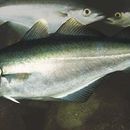Diagnostic Description
provided by FAO species catalogs
A small barbel at tip of lower jaw. Lateral line smooth along its entire length. Colour: brownish-green dorsally, only slightly paler ventrally; fins coloured like the body, except for pelvics which are pale; lateral line pale.
Wheeler, (1969)
- bibliographic citation
- FAO species catalogue. Vol.10. Gadiform Fishes of the world (Order Gadiformes). An Annotated and Illustrated Catalogue of Cods, Hakes, Grenadiers and other Gadiform Fishes Known to Date.Daniel M.Cohen Tadashi Inada Tomio Iwamoto Nadia Scialabba 1990. FAO Fisheries Synopsis. No. 125, Vol.10. Rome, FAO. 1990. 442p.
- author
- Food and Agriculture Organization of the UN
Distribution
provided by FAO species catalogs
Barents Sea and Spitsbergen to Bay of Biscay, around Iceland, southwest Greenland, and in the western Atlantic from Hudson Strait to North Carolina, although rare at the extremes of the range.
- bibliographic citation
- FAO species catalogue. Vol.10. Gadiform Fishes of the world (Order Gadiformes). An Annotated and Illustrated Catalogue of Cods, Hakes, Grenadiers and other Gadiform Fishes Known to Date.Daniel M.Cohen Tadashi Inada Tomio Iwamoto Nadia Scialabba 1990. FAO Fisheries Synopsis. No. 125, Vol.10. Rome, FAO. 1990. 442p.
- author
- Food and Agriculture Organization of the UN
Size
provided by FAO species catalogs
Reaches nearly 130 cm total length; common from 30 to 110 cm.
- bibliographic citation
- FAO species catalogue. Vol.10. Gadiform Fishes of the world (Order Gadiformes). An Annotated and Illustrated Catalogue of Cods, Hakes, Grenadiers and other Gadiform Fishes Known to Date.Daniel M.Cohen Tadashi Inada Tomio Iwamoto Nadia Scialabba 1990. FAO Fisheries Synopsis. No. 125, Vol.10. Rome, FAO. 1990. 442p.
- author
- Food and Agriculture Organization of the UN
Brief Summary
provided by FAO species catalogs
An active, gregarious, pelagic fishoccurring in inshore and offshore waters to about 200 m depth.Migrations are known to occur, especially for spawning, to coastal waters in spring and to deeper waters in winter. Also, long-distance north-south migrations are known, both for Europe and America. During their first 2-3 years of age, saithe remain in shallow coastal waters.Growth is rapid: at 1 year, ca. 20 cm, 2 years, 35 cm, 3 years, 50 cm, 5 years, 60-65 cm, 10 years, 94-97 cm, 15 years, 108 cm. Maximum age is 25 years. European saithe grow faster in the southern part of their range, but it is not known whether this also applies to the North American population. First maturity is reached between 5 and 10 years of age in the European population and apparently earlier (at 3 years) in the Gulf of Maine. Spawning occurs in late fall and winter; in the western North Atlantic it begins in September and ends in March, with a peak from November to February. Average females lay about 220 000 eggs, but in large fish, the fecundity may reach 4 000 000 eggs per female. Smaller fish in inshore waters feed on small crustaceans (copepods, amphipods, euphausiids) and small fish, while the large saithe prey predominantly upon fishes.
- bibliographic citation
- FAO species catalogue. Vol.10. Gadiform Fishes of the world (Order Gadiformes). An Annotated and Illustrated Catalogue of Cods, Hakes, Grenadiers and other Gadiform Fishes Known to Date.Daniel M.Cohen Tadashi Inada Tomio Iwamoto Nadia Scialabba 1990. FAO Fisheries Synopsis. No. 125, Vol.10. Rome, FAO. 1990. 442p.
- author
- Food and Agriculture Organization of the UN
Benefits
provided by FAO species catalogs
An important commercial species, similar to cod and haddock which it replaces in some products. The catch reported for 1987 in the FAO Yearbook of Fishery Statistics totalled 483 758 t, of which 404 102 t, were taken in the northeastern Atlantic (Norway: ca. 148 000 t, Iceland: ca. 78 200 t, France: ca 69 900 t, Faeroe Islands: ca 41 600 t, Germany: ca. 28 800 t, UK: ca. 22 700 t, Denmark: ca. 8 200 t, and others), and 71 879 t in the northwestern Atlantic (Canada: ca. 47 700 t, UK: ca. 20 700 t, France: ca 2 700 t and others). In the northwestern Atlantic, 80% of the catches are taken from October to December when this fish forms large schools. The total catch reported for this species to FAO for 1999 was 339 987 t. The countries with the largest catches were Norway (197 969 t) and Faeroe Islands (34 5423 t). Saithe are caught with purse seine and Danish seines, trawls (bottom and pelagic), and longlines; also trolling with spoons is used. They are marketed fresh, chilled as fillets, and frozen; also canned, dried-salted and in brine.
- bibliographic citation
- FAO species catalogue. Vol.10. Gadiform Fishes of the world (Order Gadiformes). An Annotated and Illustrated Catalogue of Cods, Hakes, Grenadiers and other Gadiform Fishes Known to Date.Daniel M.Cohen Tadashi Inada Tomio Iwamoto Nadia Scialabba 1990. FAO Fisheries Synopsis. No. 125, Vol.10. Rome, FAO. 1990. 442p.
- author
- Food and Agriculture Organization of the UN

